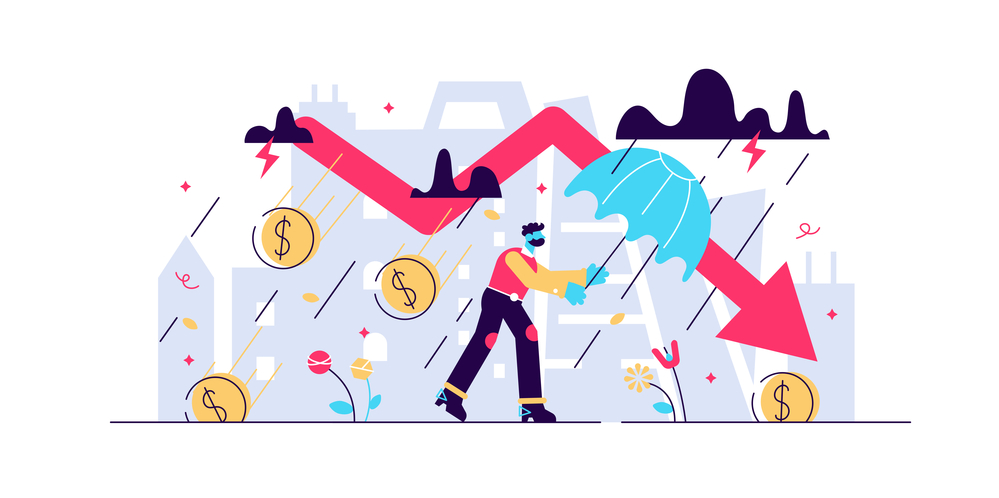Editorial Note: We earn a commission from partner links on Doughroller. Commissions do not affect our authors’ or editors’ opinions or evaluations. Learn more here.
I’m not a huge Dave Ramsey fan. I’ve listened to his show from time to time and read his books. He can be entertaining, and he has helped a lot of people. But his dogmatic,” I’m right, and you’re wrong” approach to personal finance just rubs me the wrong way.
Of course, Ramsey can be inspiring when figuring out ways to get out of debt. One day several years ago after listening to his show, I pulled out a piece of paper and wrote that I would get myself out of debt.
I was 40 when I made that promise to myself. By the time I turned 45, I had reached a significant milestone in my journey to get out of debt—I paid off my last school loan, leaving our mortgage as our only remaining debt.
When I first embarked on my debt-free journey, our non-mortgage debt consisted of school loans and a home equity line of credit. The home equity line was the result of several purchases, including a kitchen renovation and consolidating some credit card debt. We made the last payment on the home equity just a month before paying off the school loan.
In total, my wife and I paid off $237,428.13 in debt in less than five years.
So, how did we do it? And more importantly, how can you begin and finish a journey toward a debt-free life?
Five Simple Ways to Get Out of Debt
Based on our experience of climbing out of debt, there are five important steps that you need to take if being debt-free is your goal:
- Learn to live without debt.
- Implement the debt snowball strategy.
- Lower your interest rates.
- Increase your income.
- Dig in for the long haul.
1. Learn to Live Without Debt
This has become a bit of a cliché, but it is without a doubt the most important (and hardest) step if you want to tackle your debt. Unless you are teetering on bankruptcy, paying your debts is the easy part. But staying away from new debt? Now that is a challenge.
Learn More: 6 Keys to Setting Financial Goals
The most critical aspect of learning to live without debt is living beneath your means. Translated, that means you must commit to living on less than you earn, regardless of your income level. If you’re only in a moderate amount of debt, you may accomplish that simply by cutting excess spending in your budget. But if you’re deep in debt, you may need to completely rearrange your finances. That’s easier said than done because debt has become a lifestyle for so many people.
We started paying cash for cars, paying off credit card debt in full each month, and just saying ‘No’ to big purchases we couldn’t afford. Once you develop the habit of living without debt, you’ll likely find that your quality of life has not changed a bit.
Here’s what we found to be important to avoid piling on more debt:
An Emergency Fund: You’ve no doubt heard it a thousand times, but an emergency fund is a must. Even before you begin to pay extra on your debt, having some money set aside will help you handle unexpected expenses and give you a wonderful feeling of control over your finances.
I’d recommend building up a one-month cushion before paying extra on debt. Once you have a month’s worth of expenses saved (in a high-interest savings account, of course), you can begin paying down debt while continuing to build your emergency fund at a slower pace.
Save for big purchases: It’s absolutely critical that you include in your monthly budget the cost of large purchases (cars, education) and periodic expenses (car insurance and vacations). Don’t use your emergency fund for these!
Plan to have fun: You shouldn’t deprive yourself of any and all fun. I firmly believe that being debt-free is not actually the goal, but rather a means to a life full of choices and endless possibilities. So, what’s the point if you’re miserable for years while you work your way out of debt? More importantly, most people cannot maintain total financial deprivation for long. And just like a yo-yo diet, the result can be even more debt than you started with.
Related: How to Budget for a Vacation
2. Implement the Debt Snowball Strategy
If you’ve been studying up on getting out of debt, you’ve probably already heard about this strategy. The debt snowball is the brainchild of Dave Ramsey. It uses four basic steps:
- List your debts, from the smallest to the largest.
- Plan to make minimum payments on all debts except the smallest.
- Make the largest payment possible on the smallest debt.
- Once the smallest debt is paid, concentrate on the next smallest, then the next smallest after that, until all debts are paid.
At its core, the debt snowball is a divide-and-conquer strategy. You’ll concentrate on the smallest debt first because that will be the easiest to pay off in the shortest amount of time. In addition, you’ll gain an important psychological advantage of having at least one debt paid.
Once the smallest is paid off, you can redirect funds being paid for that debt to the next debt. As you pay off each debt, your cash flow and your confidence will build, helping you to finish the job of paying off all your debts.
There are different variations on the debt snowball. One is concentrating on paying off the debt with the highest interest rate. That will enable you to gradually reduce your interest expense and increase your principal repayments. But it may be difficult to accomplish if the debt with the highest rate is also your largest debt.
3. Lower Your Interest Rates
This one is simple. Take a look at all of your debt, and take steps to reduce the interest rates on each loan. Removing this section because mortgage rates are well above 7%, and this is unlikely to be a winning strategy. If you have credit card debt, use 0% balance transfer credit cards to lower your rates. We did this for several years, and the result was significantly lower interest payments and less time to get out of credit card debt.
Another way to lower the interest you’re paying on your debts is through a debt consolidation loan. This can be done by taking out a personal loan. You can borrow as much as $50,000 on a personal loan, which will be unsecured. The loan will have a fixed rate and monthly payment, and be fully paid in three or five years.
But there are a couple of caveats when it comes to debt consolidation.
First and foremost, debt consolidation loans don’t eliminate debt – they just rearrange it. It will only make sense if you have good or excellent credit, and the interest rate you’ll pay on the new loan will be lower than what you are paying on your credit cards. If you have impaired credit, you may be declined for the loan or face an interest rate as high as 35.99%.
The other issue is that you must have the discipline to focus on paying off the debt consolidation loan and not adding any new debt. This can be more difficult than it sounds if you’ve been accustomed to using credit liberally in the past. Debt consolidation only makes sense if you will use it to pay off your debts once and for all. It will be completely counterproductive if you ultimately use it as a way to get even more credit.
Self is a unique company that offers to help you build your credit score. Instead of applying for a credit card that has high fees or a high interest rate, Self has created a way for you to increase your credit score through a self-funded loan.
After you’ve applied for your loan and selected a payment option, you’ll be on the path to building your credit. Once you’ve completed your payments, the entire principal is returned to you minus the interest and $9 loan fee.
4. Increase Your Income
This one was our secret weapon. When I started the Dough Roller in 2007, I had no idea it would turn into a business. Within the first four years, the websites that I launched, combined, generated a full-time income. I kept my job at the same time, which allowed us to put the income from the business toward our debt (and now savings). I have since retired, focusing all of my efforts on Dough Roller and my other sites.
I’m not suggesting you start a website necessarily. But I am saying that if you can find a way to generate extra income, it will supercharge your efforts to pay down your debt.
How to Make Money with a Blog
My experience aside, there are plenty of ways to make additional income. One is to sell used items on eBay, Facebook Marketplace, or Craigslist. You may have thousands of dollars in unused items stored in different parts of your home that could be used to pay down or pay off debt.
Of course, the most traditional way to earn extra income is by taking a part-time job. That can be a grind, but it may be worth doing for six months or one year to help kickstart your debt payoff effort. Earning an extra $500 a month for six months will give you $3,000 to pay off debt.
The easiest way to accelerate debt payoff – even without increasing your income – is to apply windfalls to your debt balances. For example, by using your income tax refund or a bonus check to pay off debt, you’ll be able to move the process forward, even without earning any additional income.
5. Dig in for the Long Haul
I alluded to this above, but it’s critical that you be realistic about how quickly you can pay off your debt. Dave Ramsey speaks of “gazelle-like intensity” when it comes to getting out of debt. That’s a great image, but we need to be careful.
To me, balance is important in all aspects of life, including finances. As a result, my wife and I invested in retirement accounts and our emergency fund while we paid down our debt. While this meant it took us a bit longer to get out of debt, it also helped us develop the habits of saving and investing, and it provided a solid financial foundation for our family.
There are still programs such as the goals feature within Mint.com, which can help you track your progress along your debt-free journey. This can help you make a plan to get out of debt, see where you stand, and calculate your payoff date(s). All of this can help you get out of debt faster.
Overall, however, it will be mission-critical for you to be as realistic as possible about your debt payoff plan. If you’re only looking at paying off a few thousand dollars, that may be a goal you can achieve in one or two years. But if you owe tens of thousands of dollars in excess debt, you’ll need to be ready to commit to five years or longer to make it happen.
So much of getting out of debt is psychological. That requires preparing yourself, your spouse, and your family emotionally, as well as financially. That means setting a reasonable timeframe for the payoff and being prepared for the sacrifices that will need to be made during that time.
Frequently Asked Questions (FAQ)
What is the fastest way to get out of debt?
The fastest way to get out of debt is through a combination of strategies. That’s why I included five steps in this article. You may need only one or two of them, but the more you implement, the faster you’ll get out of debt.
What is the simplest way to get out of debt?
The answer to that question is a matter of opinion. But I think the debt snowball is the simplest. That’s because it can usually be done without needing to increase your income or even make radical cuts in your budget.
You’ll concentrate on paying off your smallest debt first, then use the funds that would go toward that monthly payment toward paying off the second smallest debt, and so on.
How to get out of $5,000 in debt fast?
As debt burdens go, $5,000 is on the more manageable end of the scale. If you want to pay it off quickly, getting a low-interest personal loan can get the job done. As far as speed, if you set the loan term for 12 months, the debt will be completely paid in just one year.
You CAN Get Out of Debt
This article is about the journey my wife and I embarked on to pay off over $200,000 in debt. If we can do it, you can do the same. Implement the strategies in this article, and be prepared to put in the time, effort, and financial sacrifices it will require. But I can tell you from experience, what you will feel at the end of your debt payoff journey will more than justify the price you’ll pay between now and then.
If you want to learn about the above topics in more detail, here are some additional resources to help you tackle your debt:



